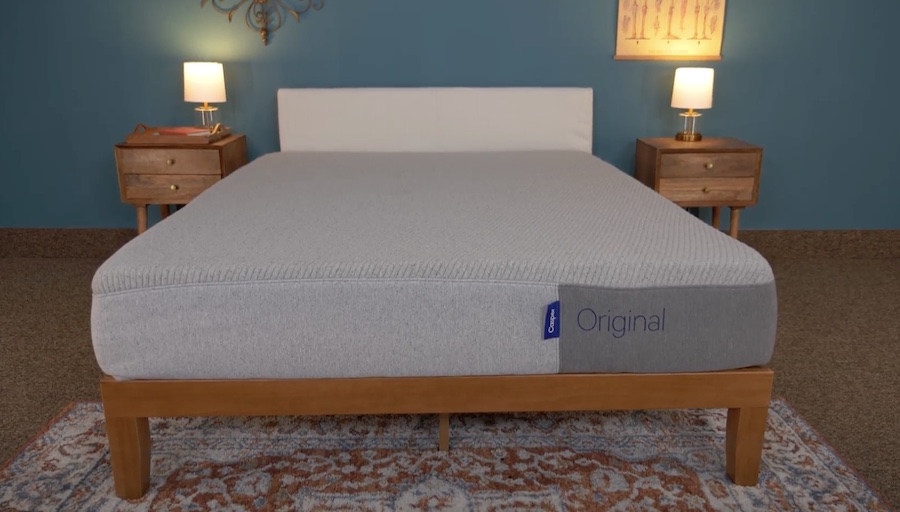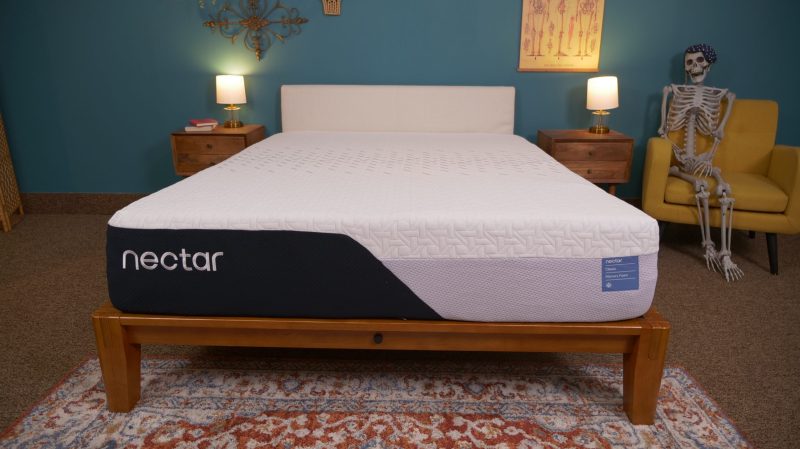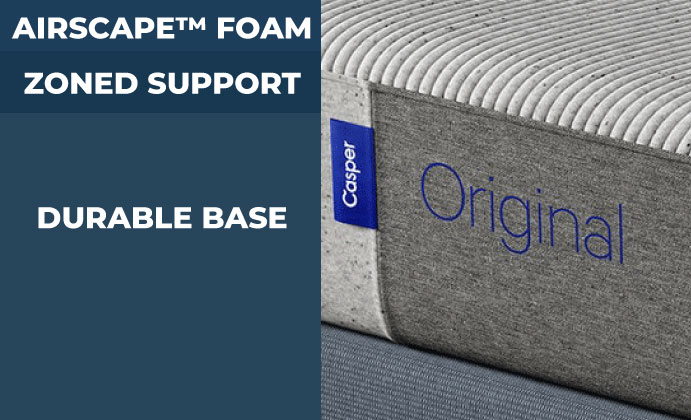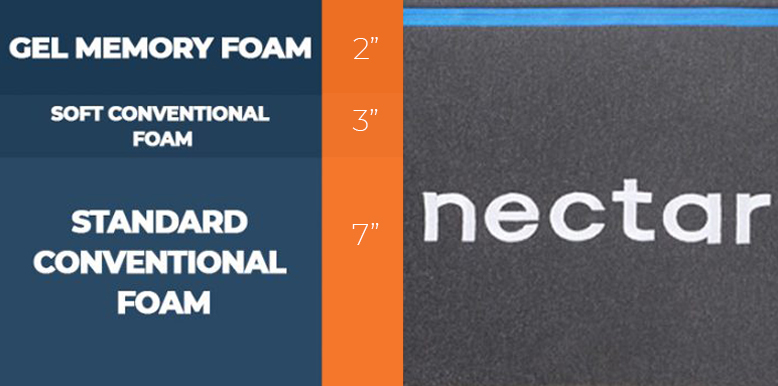Our Casper vs. Nectar comparison takes a look at two all-foam mattresses; one with a support system with zoned firmness for added versatility and another built to provide exceptional pressure relief with a forever warranty.
Casper got their start in 2014, one of the first in the online mattress business, and they’ve been continually working to keep their flagship bed fresh and current. Nectar’s start is a bit more recent, but they’ve quickly gained ground by offering top-notch value.
Which brand will win a place in your home? We’ll review both mattresses and compare them to one another to help you pick one that suits you best.
Product
Type
Score
Watch Our Video Comparison of the Casper vs. Nectar


Casper Original Mattress

Product Details
Our Recommendation
Financing Options
Financing options are available for this mattress.
Who I’d Recommend the Casper For
- People looking for advanced spine support – Casper’s Zoned Support™ should provide great spine alignment, especially to those who carry more weight around their middles and need an extra boost of firmness around the bed’s center.
- Hot sleepers – Casper’s going to provide a gentler cradle, which should leave most sleepers more “on top of” the bed than it. As a result, this can deliver more air circulation and cooling to the sleeper.
- Shoppers who need something versatile – The supportive features paired with the responsive comfort materials and medium-firm feel make it extremely versatile across a wide population of sleepers and their specific needs. Couples who need to find a bed to suit both partners are often shopping for this kind of feel that strives to be more universal.

Nectar Mattress

Product Details
Our Recommendation
Financing Options
Financing options are available for this mattress.
Who I’d Recommend the Nectar For
- People with pressure buildup – Those in the market for pressure relief should love the slower-responding memory feel of Nectar that should accommodate the curve of your shoulders and hips. Side sleepers, in particular, often need enhanced pressure relief.
- Sleepers looking for a deeper hug – If you favor a feel that holds you more inside the bed for a cozy, nestled sleep experience, Nectar’s deeper hug should fit the bill. Modernized features such as cooling technology and responsive layers should keep you from feeling stuck or overheated.
- Value seekers – The quality of the foams and certifications may suggest a higher price point, but Nectar is able to keep their price lower, in part, because of their online sales model. You’re getting a lot of quality for your dollar with this brand.
Comparing Casper vs. Nectar: Top Similarities
- All-foam construction – Both of these mattresses are made entirely out of foam. Although the layers are different, both of them contain only foam.
- Medium-firm feel – Casper and Nectar have a similar medium-firm feel that makes them a good fit for a similar group of sleepers.
- Excellent motion isolation – Both of these beds are all-foam models, so they foster excellent motion isolation, making them a good option for couples.
Comparing Casper vs. Nectar Key: Differences
- Height – Casper is 11 inches tall, and the Nectar is slightly taller at 12 inches high.
- Sinkage – Nectar offers a deep hug, while the Casper is a better choice for gentle cradling.
- The price – Although the price difference isn’t so drastic, Casper is slightly more expensive.
Comparing Firmness, Support & Feel
Firmness
Both mattresses score within a very similar firmness range on our scale that measures from 1 to 10, with 1 being the softest and 10 being the firmest. Casper comes in at a 6, and Nectar is a 6.5. These are versatile medium-firm scores that usually indicate mattress designs that can accommodate a range of different preferences and needs.
Despite their more specific and enhanced features, both beds are built to suit a variety of individual sleepers in all three positions and should both work extremely well for combination sleepers.
Support
Support is important for all sleeping positions regardless of your body weight, so it’s a crucial factor to look into when choosing a mattress. Casper’s support system lies in the zoning layer that holds the heaviest parts of your body to help with spine alignment but has softer support in lighter areas like the shoulders. On the other hand, Nectar has two firmer bottom layers that help you achieve a healthy sleeping posture in every position.
Both beds do a decent job of supporting your weight and keeping your hips from sinking in too deeply into the construction.
Feel
The responsive top of Casper should react quickly to pressure and spring back into place when you roll over or get out of bed. The second layer’s Zoned Support™ offers enhanced spinal alignment with firmness tailored to different parts of your body.
Exclusive side sleepers, especially those in the market for extra pressure relief, may feel drawn to Nectar. The Nectar’s slower-responding memory materials gently melt pressure away from curvier shoulders and hips that develop the most pressure when you rest on your side.
Comparing Sinkage and Bounce
Casper’s sinkage is characterized as a gentle cradle, which should leave you softly ensconced closer to the surface of the mattress. The shallower cradle paired with a small bit of bounce close to the surface makes this bed easy to move around in, appealing to combination sleepers who want to rotate their position.
Nectar, by comparison, should hold your body in a deeper hug that contours to your curves, which are held more inside the mattress than on top of it. The responsiveness in the second layer should help you reposition despite the bed’s minimal level of bounce.
Comparing Motion Transfer

Despite a variance in responsiveness and bounce, there is no significant difference between these two all-foam constructions in this category. Foam works exceptionally well when it comes to isolating movement, so light-sleeping partners shouldn’t be jostled awake by more active partners.
Motion isolation is crucial for couples sharing a bed, especially if one person is a restless sleeper, tossing and turning frequently. However, it’s also helpful for people who share their beds with kids or pets. The foam layers in both beds should help isolate motion so that it doesn’t transfer from one side to the other.
Comparing Cooling
Cooling is another critical factor to consider if you’re sharing a bed because couples tend to sleep warmer than single individuals. However, even single individuals who struggle with sweating and hot flashes should keep an eye out for cooling features.
Foam beds don’t have as much airflow as innerspring ones, but Casper tackles this issue with AirScape™, which is an open-cell structure in the first foam layer. This layer has thousands of perforations to keep the air circulating. On the other hand, Nectar features gel memory foam that helps cool the foam construction. This bed also has a breathable cooling cover.
Comparing Construction (Materials & Quality)
Casper Construction
Casper is 11 inches tall, featuring three layers and a polyester cover you can unzip for easy cleaning. However, you’re only supposed to spot-clean it because machine-washing may cause it to shrink.
- The top layer’s bounce and responsiveness come from the company’s 1.5-inch proprietary formulation that works to help keep the bed easy to navigate during the night while still gently cradling your body in soft, breathable foam that shouldn’t overheat.
- The second layer’s Zoned Support™ delivers extra firmness under the hips and softer materials under the shoulders and legs for a more tailored support experience that helps keep your body level. This foam is 2 inches tall and acts as a transition unit to a firmer base layer.
- The final layer stands taller and is made from dense poly foam that completes the bed’s support system and gives it a firmer foundation.
Nectar Construction
This 12-inch construction is wrapped in a plush cover with quilted-in memory foam materials. The poly-blend cover provides a breathable surface layer. The cover features the brand’s innovative cooling technology with heat-absorbent polyethylene fibers that help wick away excess body heat. The Nectar also has three layers, including top and bottom covers.
- The first layer is made from 2 inches of gel memory foam that contours your body for optimal pressure relief in different positions. Thanks to its gel infusions, this layer is cooler than traditional memory foam.
- The second layer is slightly firmer and is also a quicker-responding material. This 3-inch soft conventional foam helps to transition from comfort to support. In addition, it’s what gives this bed bounce and responsiveness.
- The base layer is 7 inches of standard conventional foam that helps keep your body aligned and level.
Comparing Company Policies & Price
- Warranty – Casper offers a 10-year warranty, while Nectar offers an industry-leading forever warranty.
- Shipping – Casper ships to the U.S., U.K., Switzerland, Austria, Canada, and Germany. In-Home Delivery is available in some locations within the United States. Nectar ships to the contiguous United States. Shipping to Alaska and Hawaii is available for an additional fee, as is White-Glove Delivery.
- Trial Period – Casper gives you 100 nights to test the mattress, and Nectar comes with a 365-night trial.
- Returns – Casper accepts returns and offers a full refund. Nectar also offers free returns, but you may have to pay a shipping fee when returning your mattress.
- Price – Nectar is more affordable than Casper. The price is a few hundred dollars lower, depending on the size you select, which makes it a good option for budget shoppers.
| Size | Casper Price (w/o discount) | Nectar Price (w/o discount) |
| Twin | $895 | $599 |
| Twin XL | $995 | $769 |
| Full | $1,195 | $899 |
| Queen | $1,295 | $999 |
| King | $1,695 | $1,299 |
| Cali King | $1,695 | $1,299 |
| Split King | N/A | $1,538 |
Casper vs. Nectar Compared Side-by-Side
| Features | Casper | Nectar |
| Height | 11” | 12” |
| Cover | Polyester | Memory foam quilted to poly-blend fabric |
| Materials | Breathable comfort foam with dense memory and poly foams | Gel memory foam, soft conventional foam, standard conventional foam |
| Cooling | Open cell foam on top | Gel-infused memory materials, airflow through the cover |
| Firmness | 6/10 | 6.5/10 |
| Support | Great | Great |
| Motion Transfer | Minimal | Medium |
| Edge Support | Okay | Good |
| Sinkage | Gentle Cradling | Deep Hug |
| Bounce | Moderate | Minimal |
| Warranty | 10 years | Forever |
| Trial Period | 100 nights | 365 nights |
| Certifications | CertiPUR-US® | CertiPUR-US® |
| Adjustable Base Compatible | Yes | Yes |
| Shipping | Ships to U.S. and Canada | White Glove Delivery can be selected; ships to US and U.S. Territories |
| Read Full Review | Casper Mattress Review | Nectar Mattress Review |
| Made in the USA | No | Yes |
Final Thoughts
So what’s it to be? Are you going for the fantastically versatile Casper with the enhanced support system, or are you drawn to the exceptional value in Nectar’s deeper hug and extra pressure relief?
Think about the features you’d find useful and important, depending on your preferred sleeping positions, body weight, and habits. Do you sleep with a partner? How much do both of you weigh? Do you need more pressure relief or lumbar support? These are just some of the questions that can help you pick between Casper and Nectar.
Still can’t decide? Hop over to our full-length written reviews for more details to help you make up your mind.
Product
Type
Score
More Nectar Comparisons:
More Casper Comparisons:
Jill Zwarensteyn
Editor
About Author
Jill Zwarensteyn is the Editor for Sleep Advisor and a Certified Sleep Science Coach. She is enthusiastic about providing helpful and engaging information on all things sleep and wellness.
Combination Sleeper



